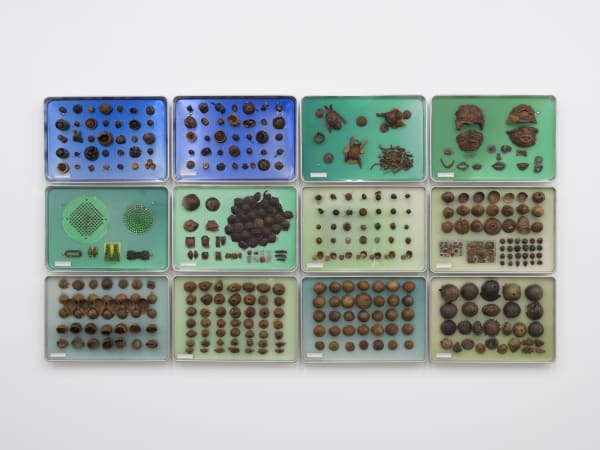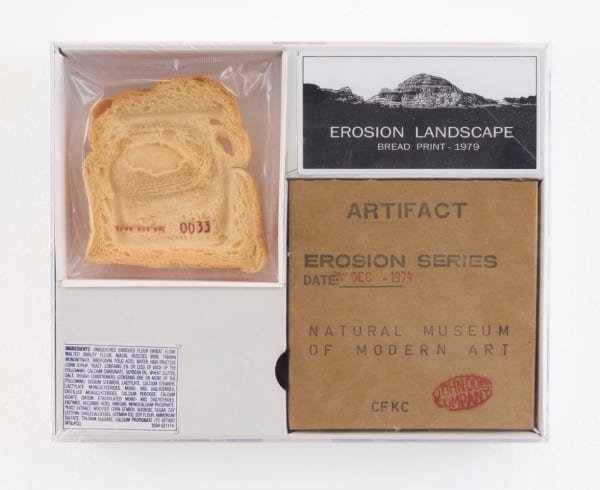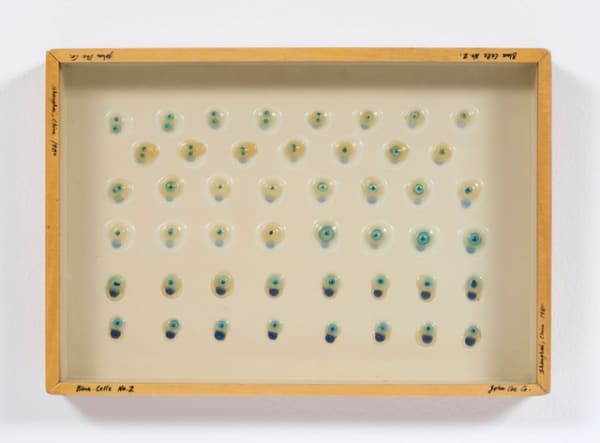Philip Martin Gallery is pleased to present, “Human Nature,” an exhibition of works (1970 to present) by Los Angeles-based artist Carl Cheng (b. 1942). The show brings together sculptural and wall-based works from Cheng’s “Nature Laboratory,” “Art Tool” and “Anthropocene Landscape” series, many of which have not been seen in decades.
For over sixty years, Carl Cheng - often working through his intentionally anonymous corporate DBA John Doe Co. - has produced pioneering pieces that explore, as critic Mark Johnstone writes, “technology and nature as levers, one applied to the other, in order to discover and reveal the beautiful wonders of each.” Cheng’s material and conceptual approach to art-making pushes the boundaries of post-minimalism, systems and environmental art. He comments, “To me picking up a handful of nuts and bolts is similar to picking up a handful of rocks or pebbles.”
The durational work, “Nature Laboratory Collection 3.0” (1970-2022), is a group of assemblages made from dried and preserved avocado skins, an ephemeral material Cheng has been working with for decades. “It’s almost like sketching. You take a material and see what you can do with it.” “Anthropocene Landscape 2” (2006), is an abstract arrangement of circuit boards that looks like the earth seen from a plane. “It came about through the realization that our computer technology is very primitive. It is all straight lines. Our human landscape is also straight lines. It wasn’t that I wanted to do it, it’s just that I thought that someone should do it... What we do in our computer is what we do in our landscape, driving our cars, etc.” Cheng is now generally regarded as one of the first artists to address the Anthropocene Era in their work. He comments, “The first time I remember the word Anthropocene, scientists didn’t like the idea of humans as an epoch that comes and goes. They wanted humans to own nature.”
Carl Cheng grew up in Los Angeles in the post-war era, one of five brothers, all of whom became involved in some way in art, architecture and design. Within a few short years, the asparagus farms of the San Fernando Valley of his childhood became sprawling suburbs, a taste of things to come. After Van Nuys High School, Cheng studied industrial design at University of California, Los Angeles (UCLA), and at the Folkwang in Essen. He became involved with the loose West Coast version of Experiments in Art in Technology; worked briefly for Charles and Ray Eames; and traveled to visit Expo ‘70 in Osaka, where he reconnected with a number of Japanese artists, like Morio Shinoda, that had also studied at UCLA.
“Organic Visualizer” (1970-2016), the earliest work in the exhibition is - per John Doe Co. product literature - “a large viewing machine illuminating a selection of ‘organic specimens’ hermetically sealed from the polluted outside world...a planetary globe model featuring a melt-down of abstract earthly elements and gasses and an opportunity to observe the same through a magnifying lens.” Many of these ‘organic specimens’ were collected by Cheng in the early 1970s during his travels in Japan, India and especially Indonesia, where Cheng lived and worked.
Indonesia was a transformational experience for Cheng. He was able to work with local craftspeople using traditional materials and explore an open method of art-making. “I had no developed plans of what I would do. Every day, I would bring my small bag with a few hand tools and take walks in the jungle or motorbike throughout the island. I started picking up seeds, shells, rocks and lots of dead insects, and anything that attracted me. I would bring them back to my desk to study them, which in turn began the act of sorting them, classifying them - ideas appeared and developed into projects.” ‘Organic specimens’ like those Cheng made in Indonesia are a vital aspect of his artistic vocabulary. They appear in other works, such as the coin-operated control panel for the now-legendary installation, “Natural Museum of Modern Art (1979).” Cheng installed and operated this major interactive piece on the at-that-time dilapidated Santa Monica Pier for almost a year, interfacing with and learning from the crowds.
The coin-operated control of Cheng’s interface grew out of his recognition that Americans “get what they pay for.” On the pier, Cheng took over the abandoned façade of Sinbad’s, a restaurant, “housed with the arcades of video attack games and Doreena’s, the Psychic Advisor’s parlor. Why not blend amusement and esthetics in an anonymous environment?,” writes critic Beverly O’Neill, noting that, “Cheng has pursued this possibility for a decade, installing coin-operated machine sculptures in public parks and state fairs.”
O’Neill comments that the control panel of “Natural Museum of Modern Art” is, “a careful handling of elements that have occupied Cheng’s thoughts for a decade. Each box, fully lined with a light sandy surface, holds small tableaux with specimens like an iguana’s head, a small creature’s jaw or a preserved praying mantis...Many references are to food: a collection of lacquer-layered wishbones, fish heads, stale bread and even three dried fish sticks...Cheng likes to preserve absurd, highly processed foods like Wonder Bread and frozen pizza. He once adhered a package of vacuum-sealed bologna to the studio ceiling [in the building he shared with Pat O’Neill and Maria Nordman] where it remained for several years, changing neither color nor texture.”
Another work in the Philip Martin Gallery exhibition, “Erosion Landscape Bread Print No. 33” (1979), is a now 43-year-old piece of Wonder Bread, still embossed with the imprint of the ‘organic specimen’ Cheng pressed into it decades ago. The ‘Artifact’ is essentially unchanged, packaged in a military ration-type olive drab container, frozen in time by the chemical preservatives of which it largely consists.
Cheng has long questioned the role of individuals in a mass media society driven by corporate interests. His intentionally anonymous corporate DBA, John Doe Co., established in 1965, has served as a means by which for Cheng to engage and critique corporate culture, work anonymously in the face of racism - especially during the Vietnam War - and interact with corporations as a corporation (an irony perhaps with regard to current American law, which now recognizes the “rights” of intersubjective entities - like corporations - on the same level as legal persons).
Carl Cheng’s “Liquid/Solid” (1980-81) works were made in China, just after the fall of the Gang of Four. Cheng set up a studio in a Shanghai International Settlement-era hotel. There, Cheng worked daily with an eyedropper, ink and glue - some of the few consumer art materials available in China at that time - sourced from the No. 1 Department Store. Cheng’s “Liquid/ Solid” works take an open approach, a method Cheng describes as, “experimenting, taking a scientific approach to aesthetics, working like Albers putting colors together - minimizing, isolating, expanding. Take one element, look at it closely, see where it goes.”
The work of Carl Cheng (b. 1942, San Francisco, CA) is the subject of a major upcoming survey, curated by Alex Klein of the ICA Philadelphia, in partnership with Roland Wetzel and Stijn Huijts, that will open at the Institute of Contemporary Art, University of Pennsylvania (Philadelphia, PA) in fall 2024, and travel to Tingley Museum (Basel, Switzerland); Bonnefanten Museum (Maastricht, Netherlands); and other institutions TBD. Cheng’s work was recently featured in such exhibitions as “Potential Worlds 2: Eco-Fictions” at Migros Museum of Contemporary Art (Zürich, Switzerland); “3D: Double Vision,” Los Angeles County Museum of Art (Los Angeles, CA); “Specters of Disruption,” de Young Museum (San Francisco, CA); and “Emerald City,” K11 Art Foundation (Hong Kong). Carl Cheng’s work has been presented in solo exhibitions at Santa Barbara Contemporary Arts Forum (Santa Barbara, CA), LIST Visual Arts Center at Massachusetts Institute of Technology (Boston, MA), and ASG Foundation Gallery (Nagoya, Japan). Museum group exhibitions include “The Photographic Object 1970,” Le Consortium (Dijon, France); “Under the Big Black Sun: California Art 1974-1981,” (Museum of Contemporary Art, Los Angeles, CA); “Proof: Los Angeles Art and the Photography 1960- 1980,” Laguna Art Museum (Laguna Beach, CA); “Photography into Sculpture,” Museum of Modern Art (New York, NY); “Vision and Expression,” George Eastman Museum (Rochester, NY). Recent gallery projects include Friends Indeed (San Francisco, CA); Altman Siegel (San Francisco, CA); and Hauser and Wirth (New York, NY). Carl Cheng lives and works in Los Angeles, CA.
Carl Cheng’s exhibition, “Human Nature,” is on view at Philip Martin Gallery from April 16 - May 21, 2022. There will be a walkthrough with the artist, and a reception, at 2pm on Saturday, April 16. To RSVP for the walkthrough please email info@philipmartingallery.com. A sequel exhibition featuring Cheng’s monumental sculpture, “Billion to 1% Trophy,” will open at Philip Martin Gallery’s new Glassell Park location in 2023.
Philip Martin Gallery is open Tuesday - Saturday from 10-5. For additional images or information please email info@philipmartingallery.com, or call 310-559-0100. Philip Martin Gallery is located at 2712 S. La Cienega Blvd, Los Angeles, CA 90034 in the Culver City area of Los Angeles between Venice Blvd. and Washington Blvd., just south of the 10 Freeway.




